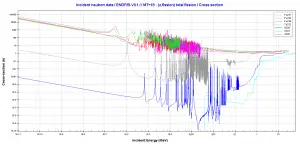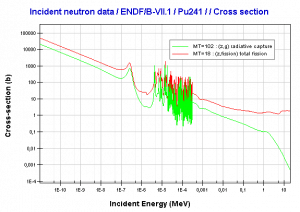Plutonium 241
241Pu is a fissile isotope, which means 241Pu can undergo a fission reaction after absorbing a thermal neutron. Moreover, 241Pu also meets the alternative requirement that the amount of neutrons produced by fission of 241Pu (~2.94 per one fission by thermal neutron) is sufficient to sustain a nuclear fission chain reaction. Its fission cross-section for thermal neutrons is about 1012 barns (for 0.025 eV neutron). For fast neutrons, its fission cross-section is on the order of barns.
Most absorption reactions result in fission reaction, but a part of reactions result in radiative capture forming 242Pu. The cross-section for radiative capture for thermal neutrons is about 363 barns (for 0.025 eV neutron). Therefore about 74% of all absorption reactions result in radiative capture of neutrons. About 26% of all absorption reactions result in fission.
It is a man-made isotope and can be found in an irradiated uranium fuel or in a spent uranium fuel. Isotope 241Pu is formed in a nuclear reactor from fertile isotope 240Pu. Absorption of a resonance or thermal neutron by the 240Pu nucleus yields 241Pu.241Pu decays via beta decay into 241Am with half-life of only 14.3 years. 241Am has relatively high cross-section for radiative capture for thermal neutrons (~680 barns – 0.025eV). This two phenomena (decrease in fissile isotope and increase in neutron absorber) cause slight decrease in reactivity of irradiated fuel when stored in a spent fuel pool.
 Fissile / Fertile Material Cross-sections. Comparison of total fission cross-sections.Source: JANIS (Java-based Nuclear Data Information Software); ENDF/B-VII.1
Fissile / Fertile Material Cross-sections. Comparison of total fission cross-sections.Source: JANIS (Java-based Nuclear Data Information Software); ENDF/B-VII.1 Plutonium 241. Comparison of total fission cross-section and cross-section for radiative capture. Source: JANIS (Java-based Nuclear Data Information Software); ENDF/B-VII.1
Plutonium 241. Comparison of total fission cross-section and cross-section for radiative capture. Source: JANIS (Java-based Nuclear Data Information Software); ENDF/B-VII.1 Source of data: JANIS (Java-based Nuclear Data Information Software); The JEFF-3.1.1 Nuclear Data Library
Source of data: JANIS (Java-based Nuclear Data Information Software); The JEFF-3.1.1 Nuclear Data Library